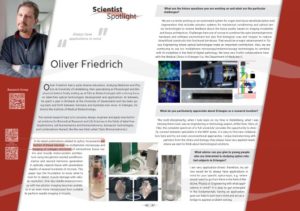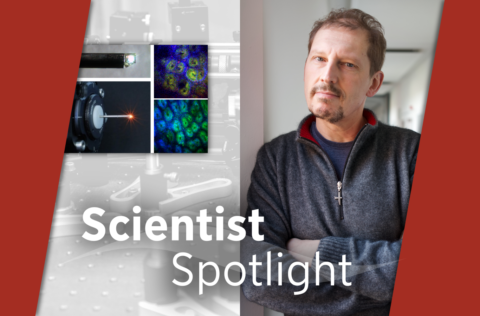Oliver Friedrich
Oliver Friedrich had a quite diverse education, studying Medicine and Physics at University of Heidelberg, then specializing as Physiologist and Biophysicist before finally ending up at FAU as Biotechnologist with a strong focus on label-free optical technologies development and applications. In between, he spent a year in Brisbane at the University of Queensland and has been going back and forth between Germany and Australia ever since. In Erlangen, he directs the Institute of Medical Biotechnology.
The central research topic is to conceive, design, engineer and apply new technical solutions for Biomedical Research and Life Sciences in the fields of label-free biophotonics, cell biomechanics and biomechatronics, bioreactor technologies, and combinations thereof, like the new field called ‘Opto-Biomechatronics’.
In his latest publications related to optics, he presents detection of tissue necrosis via multiphoton microscopy and imaging of collagen structures of extracellular tissue matrix and muscle motor-protein architecture using two-photon excited autofluorescence and second harmonic generation in optically cleared tissue with penetration depths of several hundreds of microns. This paper lays the foundation to know what to look for to detect muscle damage with cellular resolution. One day needle endomicroscopy with two-photon imaging becomes available in an even more miniaturized form suitable to perform needle imaging in muscle.

We are currently working on an automated system for organ and tissue decellularization and regeneration that includes actuator systems for mechanical conditioning and optical sensor technologies to receive feedback about the tissue quality based on imaging modalities and tissue architecture. Challenges here are of course to combine the opto-biomechatronics hardware and software environment but also find biological cues and ‘recipes’ to mature bioartificial constructs into functional bio-tissue. That would be a major advancement in Tissue Engineering where optical technologies make an important contribution. Also, we are continuing to use our multiphoton microscopy/endomicroscopy technologies to combine with AI modalities in the field of digital pathology. We have very fruitful collaborations here with the Medical Clinics in Erlangen (i.e. the Department of Medicine I).

The multi-disciplinarity; when I look back on my time in Heidelberg, what I was missing there most, was an engineering or technology aspect, at the time. Here, at FAU, the complete spectrum of a ‘full university’ provides the opportunity to directly connect between specialists in the MINT areas. It is easy to find new collaborators here and try out even unconventional approaches. I enjoy brainstorming with partners from the clinics and biology; they always have very applied needs where we start to think about technological solutions.

I am very application-driven; therefore, my advice would be to always have applications in mind for your specific optics-topic, e.g. ‘where would I want to go from there in the field of Medicine, Physics or Engineering with what applications in mind?’ It is easy to get entangled in the fundamentals; having an application goal can help to sort one’s mind and act as a bridge to applied problem-solving.
